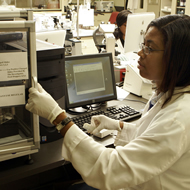
Environmental Factor, August 2008, National Institute of Environmental Health Sciences
PCBs Are Topic of Superfund Workshop
By Pat Ramstad
August 2008


Just three weeks before the Flood of 2008 engulfed the state of Iowa, 140 scientists from the United States and nine foreign countries convened in Iowa City, Iowa, to attend the "The Fifth Polychlorinated Biphenyl (PCB) Workshop: New Knowledge from Old Pollutants." Sponsored by the NIEHS Superfund Basic Research Program (SBRP), the workshop was held May18 - 22, near the campus of the University of Iowa, the event’s host and co-sponsor.
Workshop themes reflected the evolution of research interests among scientists concerned with the detection, metabolism, toxicity, remediation and risk assessment of PCBs since they began meeting biennially in 2000. The PCB Workshops alternate between North America and Central and Eastern Europe. Plenary sessions encourage an exchange of information on the latest findings from diverse critical disciplines. Sessions chairs from the University of Iowa, the University of Kentucky, Brown University and University of California, Davis represented four of the NIEHS-funded Superfund Basic Research Programs.
Thomas Sharpe, Ph.D., University of Iowa associate vice president for Economic Development, opened the meeting’s Sunday evening reception with welcoming remarks, followed by PCB Workshop host and organizer Professor Larry Robertson, Ph.D., of the University of Iowa. Robertson, who is also director of the Iowa Superfund Basic Research Program (isbrp) acknowledged the support provided by NIEHS and thanked all the sponsors.
Guest lecturer William Suk, Ph.D., NIEHS acting deputy director, spoke on "Strategies for Addressing Environmental Health Needs and Disease Outcomes." Honorary guest Larry Hansen, Ph.D., professor emeritus at the University of Illinois at Urbana-Champaign, provided historical perspective with his lecture on "Forty Years of PCBs — More or Lessons?" Hansen's talk reminded participants of the impact that the simultaneous input from diverse critical disciplines has had on the understanding of PCB health effects over the years. Hansen’s presentation also marked a celebration of his retirement.
The three-day program included six half-day sessions, with topics ranging from the analytical “Emissions and Transports of PCBs in Natural and Urban Systems” to policy and regulatory issues, such as one on toxic equivalency factors (TEFs) titled “TEFs: New and Novel Approaches; Implications for Risk Assessment.”
Sessions on "Chiral Aspects of PCBs Transport, Metabolism and Distribution" and "New Aspects of Environmental Metabolism of PCBs: From Microbes to Plants to Animals" provided the latest information on environmental, plant and animal metabolism of PCBs.
Mechanistic considerations included a session on the “Reproductive, Developmental and Cardiovascular Effects of PCBs” and the application of those findings to individuals facing real – life exposures in “Anniston: The Most Severe PCB Community Exposure.”
As she has for previous PCB Workshops, presenter Linda Birnbaum, Ph.D., of the U.S. Environmental Protection Agency (EPA), contributed a summary presentation at this PCB Workshop. She observed that half of the sessions dealt with environmental sources, fate and transport and transformation.
Birnbaum, who was a scientist at NIEHS from 1980-2001, also noted findings common to previous workshops – that most PCBs ever made are still present in the environment, microbial remediation still needs work, congener information is the key to sources and mechanisms, and lighter congeners are in the air. She then pointed out major differences between this and previous workshops, including decreased emphasis on toxicology except for developmental neurotoxicity, and less focus on endocrine disrupting effects of PCBs.
(Pat Ramstad is program coordinator of the Iowa Superfund Basic Research Program at the University of Iowa.)
"Science Camp..." - previous story ![]()
![]() next story - "Cline Explores Circuits..."
next story - "Cline Explores Circuits..."
August 2008 Cover Page



